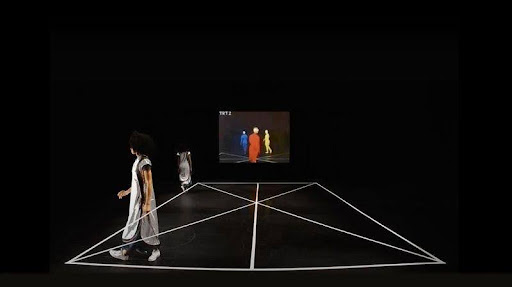
At first glance “Kandis Williams: A Surface” is visually striking — awash in mirrored textures, collaged images, and layered screens. But at its core, the exhibition is a rigorously intellectual and emotionally resonant excavation of history, visual culture, and the embodied experience of Black life.
Now on view at the Walker Art Center in Minneapolis, “A Surface” marks the first major Midwest presentation of Kandis Williams’ work. It is curated by Taylor Jasper, the Susan and Rob White assistant curator of visual arts, with support from Laurel Rand-Lewis, Walker’s curatorial fellow in visual arts.
Jasper, who has worked closely with Williams for more than five years, approaches curation with an emphasis on co-authorship.
“I really like for our relationships to evolve over time,” Jasper said. “What the artist brings is the work, and what the curator brings is not only spatialization but accessibility, creating entry points into complex work so that larger communities can engage with it.”
Multidisciplinary and thematically dense, the show spans American filmmaking, theater, dance, Greek mythology, and racialized violence. Rather than overwhelm, it invites the viewer in — offering both surface and depth, immediate impact and layered meaning.
Collage, Jasper noted, is not only a visual technique in Williams’ practice but also a conceptual methodology. “It’s how she gathers information, constructs meaning, and moves between mediums,” she said. “Each section of the exhibition is anchored by a major video work. Surrounding those videos are attendant collages, works on paper, mirrored plexiglass, lenticular prints — all responding to the videos’ themes.”
Williams’ practice is deeply research-based. As she cuts and assembles images, collaborates with dancers, or directs actors in video performances, she also draws from critical theory, online discourse, and archival materials. The result is a body of work that reflects and critiques the systems we live within — and against.

The exhibition’s title, “A Surface,” points to Williams’ formal engagement with materiality, but also to broader conceptual aims.
“She uses the surface as a space for critical engagement, resistance and liberation,” said Jasper. “It’s about what lies beneath and beyond what we see.”
Two years in the making, the exhibition also includes the forthcoming release of a catalog. Jasper emphasized the collaborative process with Williams: “The floor plan went through multiple iterations,” she said, “but ultimately the vision had to coalesce.”
Centering the visitor experience was a curatorial priority, especially in making the show’s references — ranging from Black cultural memory to white femininity and classical iconography — feel accessible rather than abstract.
“We worked hard to make the language accessible, not overly academic,” Jasper said. “We wanted to meet people where they are.”
The feedback so far has been powerful. Several visitors, especially Black community members, have expressed a deep personal resonance with the themes.
“One person told me they could see their own lived experience reflected directly in the work,” Jasper said.
One piece, “Atomic Karen,” particularly resonated with a white woman visitor. The work critiques the violence embedded in the archetype of the “Karen” — a white woman whose weaponization of victimhood can have life-threatening consequences for Black people.
“There’s a section interrogating the power dynamics embedded in white womanhood,” Jasper said. “That work really made it plain to her how the Karen archetype, while often dismissed as a stereotype, actually represents a structure of harm — and what’s at stake for people in Black bodies when that harm is inflicted.”
With six video installations, Jasper faced the curatorial challenge of spatializing media-heavy work without compromising intimacy or clarity.
“There’s always concern about sound bleeds,” she said. “But some of my colleagues told me the layout not only mitigated that but actually used sound in intentional, dynamic ways. That was gratifying to hear.”
The resulting interplay of silence and sonic intensity becomes part of the exhibition’s atmosphere — a sensory echo of the fragmentation, embodiment and contradictions that Williams explores.
Though Williams’ work may appear niche or theoretical, Jasper insists it functions as a shared mirror. “We all live within a white supremacist society in the United States. Whether you’re a person of color or not, these are structures we all live under,” she said.
What makes Williams’ art so affecting is its openness. Rather than dictating a single interpretation, it creates space for recognition, discomfort and reflection.
“She’s not trying to tell people what to think,” Jasper said. “She’s offering a foundation for reflection — inviting people to look more closely and with more care.”
For those willing to look beyond the surface, the reward can be profound.
For more information, visit www.walkerart.org.
Aria Binns-Zager welcomes reader responses at [email protected].
